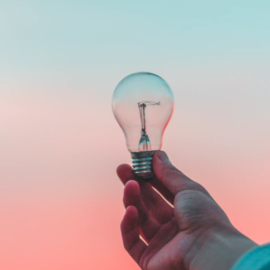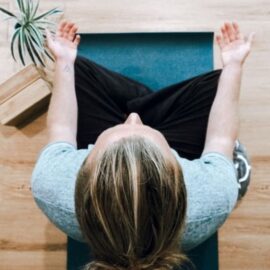

This article gives you a glimpse of what you can learn with Shortform. Shortform has the world’s best guides to 1000+ nonfiction books, plus other resources to help you accelerate your learning.
Want to learn faster and get smarter? Sign up for a free trial here .
Do you get irritated, angry, anxious, or emotional more easily than you would like? How do you rid your mind of everything that doesn’t serve you?
If you suffer from anxiety, anger, or any other emotional struggles, it’s a sign that your mind is troubled and needs healing. Like with any ailment, the first step to healing your mind is to acknowledge that intervention is needed.
Here are some strategies for healing your mind from psychic irritants.
Healing Your Mind
The mind is no less important than the body, but most of us don’t give it as much care as we give to our physical body: We give our bodies nutritious food, exercise to keep them strong and healthy, and make sure we get enough sleep to recuperate them.
Our minds, on the other hand, are left to their own devices. As a result of neglecting the mind, we develop all kinds of problems: anxiety, insomnia, racing thoughts, inability to concentrate, and so on. Left unchecked, these problems can spiral out of control and develop into a full-blown diagnosis that needs professional intervention.
Let Go of Past Hurts
The first step to healing your mind is to let go of all the mental junk from your past: painful memories, grudges, and regrets. According to Michael Alan Singer, the author of The Untethered Soul, clinging to the pains from your past creates samskaras—mental imprints formed as a result of unresolved past experiences. For example, if driving past a mustang like your ex-girlfriend’s disturbs you, that’s a manifestation of a samskara—you’re affected in the present by something that happened in the past.
When you fall into samskaras, you fail into unawareness. You encounter a trigger—some sight, sound, situation, or other experience that’s linked to one of the Samskaras stored in your heart (such as the smell of the perfume your ex-wife used to wear before your marriage imploded)—and this trigger pulls you down into the disturbed energy. From there, you see everything through the negative energy’s distorted haze. Eventually, the negativity plays itself out and subsides, and you rise again. However, if your life hits another blockage while you’re already fallen, and you make life decisions from that negative inner state, then a series of cascading crises can occur, resulting in a downward spiral.
When life inevitably hits your stored negative stuff (your Samskaras), let go of the negativity by
- noticing your energy flow starting to tighten into jealousy, anger, or whatever it is.
- relaxing and remembering yourself as the self, the objective witness of experiences.
- practicing non-reactiveness: Just let the memory flow through you and out of you without any resistance; recognize this as an opportunity for healing.
TITLE: The Untethered Soul
AUTHOR: Michael A. Singer
TIME: 31
READS: 101.3
IMG_URL: https://www.shortform.com/blog/wp-content/uploads/2021/05/the-untethered-soul-cover.png
BOOK_SUMMARYURL: the-untethered-soul-summary-michael-a-singer
AMZN_ID: XYZ
Practice Mindfulness
Mindfulness is the key to healing your mind from anxiety and agitation because it helps you interrupt anxious and worrisome thoughts. For example, when you remember the bills, you might start worrying—Do I have enough money to pay them? Did I already miss a due date? Without mindfulness, you might not even notice these thoughts—you might just feel your stress increasing without knowing why. With mindfulness, you might notice these thoughts and realize that they aren’t actually helping you.
According to the author of Mindfulness in Plain English, you should make mindfulness a part of your everyday life, not just practice it during sitting meditation. To this end, practice going into a state of mindfulness while doing everyday activities—walking, drinking tea, breathing, and waiting. With time, you’ll pleasantly find that you’re meditating without thinking about it—driving down the freeway or brushing your teeth.
The below exercises allow you to practice little bits of mindfulness outside of sitting meditation.
1) Walking Meditation
Sitting meditation is by nature still, but conscious life is all about motion. To translate mindfulness practices into your everyday life, try practicing meditation while walking slowly.
Here’s how to do it:
- Find a secluded place where you’ll be free from observation and be able to take 5-10 steps in a straight line.
- At one end, stand attentively for one minute. Hands can be held in front, back, or at your sides.
- Then, while breathing in, lift the heel of one foot. While breathing out, rest that foot on its toes. Repeat.
- After reaching the other side, turn around, pause one minute, then repeat.
- Observe the sensations of taking a step – lifting, swinging, coming down, touching, pressing. Register every nuance of the movement. Don’t think about the sensation or the concept of feet.
2) Postures
For a few seconds periodically, examine your body from head to toe. How is your body arranged? How are you holding it? What is sore? What else do you feel?
The purpose is not to correct your posture or admonish yourself for having bad posture. Instead, it’s a break from the day.
3) Slow-Motion Activity
Slow down an everyday activity to 10x the time it normally takes to complete. Witness every single component of the action, pay full attention to every nuance.
For example, if you are sitting and drinking tea:
- Note your posture as you sit
- Feel the handle of the cup in your fingers
- Smell the aroma of the tea
- Note the placement of the cup, the tea, your arm, the table
- Watch the intention to raise your arm within your mind
- Feel your arm as it rises
- Feel the cup against your lip
- Feel the liquid pouring into your mouth.
Do the same with your thoughts, words, and movements.
4) Breath Coordination
When moving, coordinate the activity with your breathing. (Walking, biking, cleaning, etc). This lends a flowing rhythm to your movement and smooths out transitions.
5) Stolen Moments
Do you feel you have any periods of wasted time in your day? When you feel bored?
Turn every spare moment into meditation. Be alert and aware throughout the day. What are you feeling at the moment? Why?
Examples – while waiting at the doctor’s office; in line at the supermarket; while doing menial labor.
6) Concentration on All Activities
Aim for the situation where there is little difference between seated meditation and the rest of life. You’re supposed to be meditating all the time. If you are angry, meditate on the anger. Explore the mechanics of anger. Any stimulus can kick off a return to mindfulness.
As you gain the ability to clearly comprehend life’s activities outside of sitting meditation, you gain equanimity and perspective from meditation throughout all of life.
TITLE: Mindfulness in Plain English
AUTHOR: Bhante Gunaratana
TIME: 18
READS: 34.2
IMG_URL: https://www.shortform.com/blog/wp-content/uploads/2020/01/mindfulness_cover.jpg
BOOK_SUMMARYURL: mindfulness-in-plain-english-summary-bhante-gunaratana
AMZN_ID: B003XF1LKW
Slow Down Your Brain
When we slow our thinking and start to tune out sensory stimuli, we slip into a lower-frequency brain state characterized by alpha brainwaves. When your brain exhibits alpha frequencies, your mind is more receptive to healing because alpha waves are the bridge to your subconscious, where all your demons lurk.
In his book Breaking the Habit of Being Yourself, Joe Dispenza describes two methods for healing your mind by lowering the frequency of your brainwaves. These techniques will shift your state of being from one of thinking to one of feeling and put you in touch with your subconscious mind. You’ll perform this and all subsequent steps while seated upright with your eyes closed.
To enter these lower frequency states, focus your attention on the space you’re occupying—both the physical space your body takes up and the space of the room you’re in. You may do this in a top-down technique, where you begin by focusing first on your head and then moving your attention down your body, part by part, until you reach your feet. Then, sense the space your body takes up as a whole, and finally, the space of the room you’re in.
Alternatively, you can use a bottom-up approach, where you begin by sensing the space of the whole room and then sensing the space from your feet up to the top of your head. Dispenza suggests imagining that water is filling the room for this approach.
| Other Methods of Changing Your Brainwaves In addition to Dispenza’s induction method, there are a number of ways you can manipulate your brainwave frequencies. Brainwave entrainment is a phenomenon by which brainwaves become synchronized in response to stimuli like sounds. This method has been used by different cultures for centuries through practices like drumming and chanting. Types of brainwave entrainment include binaural and monaural beats, both of which involve playing two notes of different frequencies—or pitch—which prompts the brain to create a tone in between the two frequencies. The brain will then adjust its waves to synchronize with this perceived third frequency. Another method of controlling your brainwaves is neurofeedback, which allows you to view your own brainwave activity on a screen so you can learn to consciously move in and out of different brainwave frequencies. This method is often used to treat ADHD and mental illness, and you can also use it to maximize your mental performance. |
Final Words
Like your body, your mind can accumulate toxins—psychic irritants that can give rise to anxiety, sleepless nights, and may even develop into deep-seated psychological problems. The good news is that you can heal your mind and bring it back to its natural state of calmness and stability.
If you enjoyed our article about healing your mind, check out the following suggestions for further reading:
Mental health disorders affect millions of people and often lead to the tragic loss of life through suicide. The pain and suffering that accompany mental illness are difficult for those unafflicted to understand. Kay Redfield Jamison, a clinical psychologist living with manic-depressive disorder, has attempted to bring awareness to those experiences in her memoir. By divulging the violent, frenzied, and dangerous aspects of her disease, Jamison hopes to create more understanding about mental illness and more empathy for those who struggle to exist in the normal world.
Trauma can stem from abuse to a severe car accident to wartime combat—and cause a lifetime of flashbacks, nightmares, isolation, insomnia, hypervigilance, and rage. In The Body Keeps the Score, the author explores how diagnosing and treating trauma has evolved as new technologies, research, and fields of science emerged.
Former ABC News anchor Dan Harris believes anyone can benefit from meditation. In 10% Happier, he offers a skeptic’s journey through the world of self-help following his meltdown on live television. Harris explains how meditation is instrumental in healing the mind from anxiety and helping you become a more compassionate person. This book explores how mindfulness and meditation can improve your life and career—even by just 10%.

Want to fast-track your learning? With Shortform, you’ll gain insights you won't find anywhere else .
Here's what you’ll get when you sign up for Shortform :
- Complicated ideas explained in simple and concise ways
- Smart analysis that connects what you’re reading to other key concepts
- Writing with zero fluff because we know how important your time is






